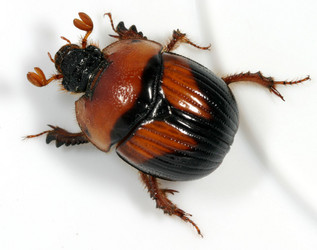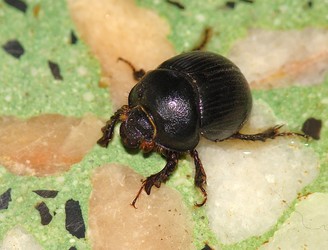Bolboceratidae
D. Jonathan Browne and Clarke H. Scholtz- Athyreus
- Blackburnium
- Bolbelasmus
- Bolboceras
- Bolbocerasoma
- Elephastomus
- Eucanthus
- Neoathyreus
- Odonteus
Note: this taxon list is still under construction. It does not yet contain all known Bolboceratidae subgroups.
Introduction
Bolboceratidae consists of about 40 genera and 400 species worldwide. Although the group is virtually cosmopolitan in distribution the largest numbers of taxa occur on the southern continents, with Australia the richest. Bolboceratids provision brood burrows with humus for the larvae.
Characteristics
Adults are characterized by 11-segmented antennae with 3-segmented club; antennal sensilla intermediate; eyes partially or completely divided; ommatidium structure eucone/exocone; epipharynx mesally indented/straight; single/double lateral tormal processes; median tormal process and lateral combs sometimes present; mandibles asymmetrical and sclerotized with concave ginglymus and convex condyle, and prostheca and mesal tuft; molar surfaces are rounded and convex on right and concave on left mandible; molar lobes with a mandible brush; galea boot-shaped bearing a long setal brush; lacinia armed and followed distally by a small boot-shaped lobe with a fine brush; palpi 4-jointed; labial palpi 4-jointed; tentorium single-foramen-type; mesothoracic spiracles generalized, intersegmentalia generalized; 1Ax ventral surface of the head with a prominent ridge, dorsal surface of the head very strongly oriented ventro-distad, neck extremely short, distal embayment is secondarily extremely deep, but very narrow, and posteriorly strengthened by a sclerotized plate; 2Ax anterior margin of the dorso-distal lobe concave) the dorsal surface of this lobe very strongly convex, subalare tendon attachment point very short, very broad, and apically shallowly and narrowly concave; 3Ax posterior section of the head enlarged dorsally to form an arm, which is proximally continuous with the neck; 2BP postero-distal section of BMP continuous with the BMP-CuA brace, the latter is very strongly convex, broad and oriented more strongly distad than posteriad, the base of CuA shifted distad; empodium present; seven abdominal spiracles; male with a well defined tegmen but membranous median lobe; well-developed genital capsule present; female genitalia without styli; 6 ovarioles present per ovary; karyotype 9+Xyp (Browne & Scholtz 1995, Scholtz & Browne 1995).
Larvae are characterized by: 3-segmented antennae; fronto-clypeal suture absent; galea and lacinia separate; 4-segmented maxillary palpi; maxillary and mandibular stridulatory areas present; epipharyngeal tormae fused/not, asymmetrical/symmetrical; legs very variable; stridulatory apparatus present/absent; spiracles biforous (Scholtz & Browne 1995).
Relationships to other Scarabaeoidea
Bolboceratidae has, until recently, been considered a subfamily of Geotrupidae. This family has usually considered to consist of four distinctive subfamilies, Geotrupinae, Bolboceratinae, Taurocerastinae and Lethrinae.
Geotrupidae have traditionally been tenuously united mainly by the fact that most of the taxa have 11-segmented antennae (although Taurocerastinae have them 10-segmented), and this shared character was previously considered important for placing the genus Pleocoma in the Geotrupidae (Paulian, 1941). In a tentative phylogenetic analysis of some major taxa in the Scarabaeoidea, Howden (1982) based the family (he treated it as a subfamily of the Scarabaeidae) on two supposedly synapomorphic [for the Geotrupidae] biological attributes, detritus-feeding and provisioning of larval burrows by the adults (Scholtz & Browne 1995).
Recently several cladistic analyses of wing characters (Browne 1991, 1993, Browne & Scholtz 1995) and all available adult, larval and biological characters have shown that "Bolboceratinae" are most closely related to Pleocomidae and only distantly related to members of the Geotrupidae. This prompted Scholtz & Browne (1995) to elevate Bolboceratidae to family status.
References
Browne, D.J. 1991. Phylogenetic significance of the hind wing articulation of the Geotrupidae (Coleoptera: Scarabaeoidea). Pretoria: M.Sc. Thesis, University of Pretoria.
Browne, D.J. 1993. Phylogenetic significance of the hind wing basal articulation of the Scarabaeoidea (Coleoptera). Pretoria: Ph.D. thesis, University of Pretoria.
Browne, D.J. & Scholtz, C.H. 1995. The phylogeny of the families of Scarabaeoidea (Coleoptera) based on characters of the hind wing articulation, wing base and wing venation. Systematic Entomology 23:
Howden, H.F. 1982. Larval and adult characters of Frickius Germain, its relationship to the Geotrupini, and a phylogeny of some major taxa in the Scarabaeoidea (Insecta: Coleoptera). Canadian Journal of Zoology 60(11): 2713-2724.
Paulian, R. 1941. La position systmatique du genre Pleocoma Le Conte (Col. Scarabaeidae).Revue Francaise de Entomologique 8: 151-155.
Scholtz, C.H. & Browne, D.J. 1995. Polyphyly in the Geotrupidae (Coleoptera: Scarabaeoidea).The Journal of Natural History.
Title Illustrations

| Scientific Name | Bolbocerasoma farctum |
|---|---|
| Location | Durham County, North Carolina, USA |
| Comments | Keyed based on Harpootlian, Scarab Beetles of South Carolina, identification confirmed by author. See http://bugguide.net/node/view/76608. |
| Specimen Condition | Live Specimen |
| Identified By | Phil Harpootlian, Patrick Coin |
| Behavior | Captured at a light |
| Sex | Female |
| Life Cycle Stage | adult |
| View | dorsal |
| Size | 14 mm length |
| Source Collection | BugGuide.Net |
| Image Use |
 This media file is licensed under the Creative Commons Attribution-NonCommercial License - Version 2.5. This media file is licensed under the Creative Commons Attribution-NonCommercial License - Version 2.5.
|
| Copyright |
© 2006 Patrick Coin

|
| Scientific Name | Bolboceras armiger |
|---|---|
| Location | Azinhal > Algarve > Algarve > Portugal |
| Specimen Condition | Live Specimen |
| Source | Escaravelho // Stag Beetle (Bolboceras armiger) |
| Source Collection | Flickr |
| Image Use |
 This media file is licensed under the Creative Commons Attribution-NonCommercial-ShareAlike License - Version 2.0. This media file is licensed under the Creative Commons Attribution-NonCommercial-ShareAlike License - Version 2.0.
|
| Copyright | © 2008 Valter Jacinto |
About This Page
D. Jonathan Browne

University of Cape Town, South Africa
Clarke H. Scholtz

University of Pretoria, South Africa
Page copyright © 1995 D. Jonathan Browne and Clarke H. Scholtz
All Rights Reserved.
Citing this page:
Browne, D. Jonathan and Clarke H. Scholtz. 1995. Bolboceratidae. Version 01 January 1995 (under construction). http://tolweb.org/Bolboceratidae/9542/1995.01.01 in The Tree of Life Web Project, http://tolweb.org/










 Go to quick links
Go to quick search
Go to navigation for this section of the ToL site
Go to detailed links for the ToL site
Go to quick links
Go to quick search
Go to navigation for this section of the ToL site
Go to detailed links for the ToL site